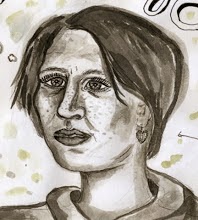People who brag about “American Exceptionalism” clearly don’t commute to work on the red line subway in Chicago. On a good day, the red line moves at a labored, halting speed that makes riders suspect that perhaps the train is being pulled by three snails, a pair of squirrels with attention deficit disorder, and an angry dachshund.
The seats in both the old cars and the new are configured in a way that creates awkward, unintentional closeness with strangers. it is hard to avoid staring at each other, or focusing absently on somebody’s butt. The seats are mysteriously covered in squares of fabric which sport suspicious brown stains, gum, or even a thick bed of nutshells and chicken bones.
People live on the trains. There used to be areas on the red line train cars that resembled mini-cubicles. I often referred to that area of the train as “the house,” as usually somebody was asleep back there, surrounded by stuff.
A dog would have a field-day on the red line. Layers of odor are so thick and vivid-- the smells surely must be solid forms with geographical borders within the train. For kicks, I used to text my friend, Svetlana, and we would trade descriptions of our daily olfactory experiences. For example: “today I smell stale egg McMuffin, aqua net, reconstituted whiskey sweat, fresh urine, pigeon feet, bleach, and a fart. She would reply with “today I smell old socks, garlic salt, Axe body spray, a hamster cage, urine, and a dusting of poop."
News about the Chicago blue line subway missing the stop and riding up an escalator at O’Hare Airport does not surprise me. Since moving back to Chicago, I have been a faithful public transit rider, and rode the red line during rush hour for six years, alternating with busses when the train became intolerable. So many of my creature portraits are inspired by people-watching on the train. I often include the el train in the background of artwork. Because I deeply love the el. And I also hate it.
I’m a self-aware claustrophobic. This quality is not a good one on crowded trains that stop a lot for no reason. Packed like sardines, we stand in a tiny train car, stalled in a dark tunnel, with only a mechanical voice telling us that the train is waiting for “signal clearance.” This makes me anxious. I acquired a flask for this reason.
I won’t even get into the etiquette of people on the train, as that is most likely a universal complaint in any city. During rush hour on a crowded train, I have had interesting conversations with strangers, have run into old friends, made new ones, have observed acts of kindness, allowed a random teenage boy to fall asleep on my shoulder... but also I have been groped, witnessed public masturbation, observed selfish behavior, dodged puke, been yelled at by mentally ill citizens, pushed out the door, encountered fights, etc. etc. You never know what to expect.
Despite my issues with the CTA, I still ride the subway. I ride it because at times, you observe a quilt of diverse faces so beautiful that you see the face of God in everybody. Peacefully cohabiting space with strangers has always given me the most hope in life-- that under all of our external differences, we are on the same team.
Despite my issues with the CTA, I still ride the subway. I ride it because at times, you observe a quilt of diverse faces so beautiful that you see the face of God in everybody. Peacefully cohabiting space with strangers has always given me the most hope in life-- that under all of our external differences, we are on the same team.
This piece in my drawing show, Escape into Absurdity, is titled, “Red Line Sardine Subway Commute.” The show is at the City Gallery in the HIstoric Water Tower, 806 N. Michigan Avenue. Hosted by DCASE. Open until April 20-- every day 10-6:30 pm. Free admission.
































